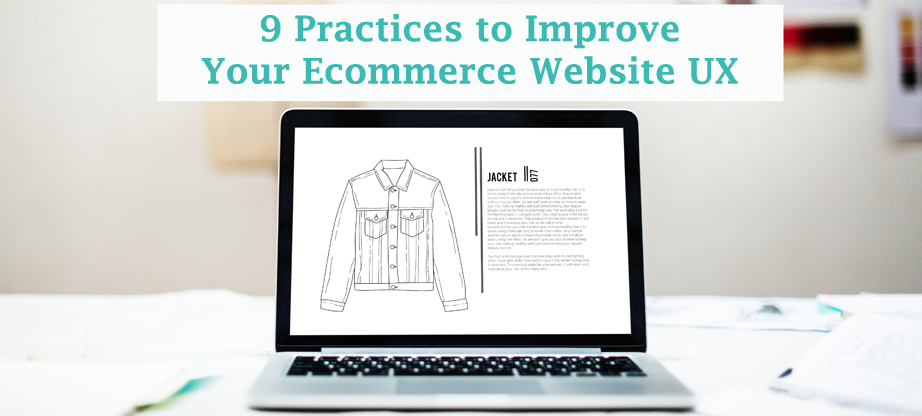9 Practices to Improve Your Ecommerce Website UX
Earlier the customer journey used to entail hopping in the car and heading to a mall or a shopping center to pick up goods. But now, the customer journey begins when online users reach for their mobile devices or open up a new window on their computers. As an online merchant, it pays to constantly consider your role in smoothing the customer journey in ecommerce. Failure to facilitate an experience from beginning to end will result in heightened abandonment rates – either before people add products to their shopping carts or after that. Moreover, when people abandon your website, you lose a sale and possibly future opportunities from all the “ones who got away.” Keep reading to learn more about the importance of optimizing your Ecommerce Website UX and some tips for doing so.

Ecommerce Website UX: The Impact of Store Abandonment
It helps to picture the entire browsing and buying process like a funnel. A successful conversion necessitates people making it all the way through.
First, come general research and browsing. At this stage, customers are simply comparing their options. How do your products stack up against competitors? What’s your selection like, and how much do various products cost? Knowing ahead of time shoppers may visit an ecommerce website multiple times before they take the plunge and actually buy something, there’s no need to panic if you notice many people dropping off at this point during the funnel.
But even once shoppers add products to their shopping carts, the conversion is far from in the bag. In fact, the average shopping cart abandonment rate across 40 different studies falls just below 70 percent. For every 10 people who go so far as to fill their shopping carts, seven of those people will drop out of the funnel before completing checkout.
Abandonment—before checkout or during—stands in opposition to profit margins in ecommerce. Thus, it’s imperative to note where people are dropping out of your funnel so you can draw conclusions as to why they’re doing this. From there, it’s possible to make improvements in response to the hopes of retaining more consumers and driving conversion rates.
Ecommerce Website UX: Eliminating Barriers to Buying Online
Here, it’s helpful to understand what is ecommerce and what the difference is between ecommerce and ebusiness. Ecommerce depends specifically upon transactions. You sell, customers buy. Ebusiness is much broader and may have a variety of end goals. The takeaway here: When you’re running an ecommerce business in particular, the most important function is setting the scene for the actual moment when a customer hits “Confirm purchase.” The nature of running an online store means your bottom line depends on getting people to buy. Your goal is clear, so your lead-up must facilitate conversions or else it’s all for naught. Keep this overarching goal in mind when you’re establishing and evaluating your online store for performance.

Ecommerce Website UX: What Do Customers Want from an Online Store?
The biggest challenge of ecommerce websites involves converting visitors into buyers and making them come back for more. If your website isn’t designed with the Ecommerce Website UX in mind, it can hurt your ecommerce business on several levels. First, users may switch from your website to one that’s more convenient and easier to use. Second, it can also affect your search ranking as Google prioritizes the most easy-to-navigate and relevant websites.
These barriers people encounter on your ecommerce website can serve as the final straw, prompting shoppers to drop out of the funnel prematurely. This is why it’s so important to provide a seamless user experience(UX) on your website.
Any online business that hopes to thrive or even survive in the present-day scenario must make an instantly engaging impression online, which needs a laser focus on the user experience.
Concentrate on these areas when you’re working to optimize the Ecommerce Website UX for your store with the eventual goal of increasing conversions.

Site Load Time
In this fast-paced world, customers want quick and swift results. If your online store takes more than a few seconds to load, you risk losing impatient visitors. Moreover, as most of the people now shop using a mobile phone, it becomes crucial that your website has responsive pages that load faster. This not only improves your website but also attract mobile-friendly users who can become potential customers.
Site Navigation
People must be able to figure out how to get where they want to go quickly. Hence, work to ensure your site structure makes sense, moving in the hierarchy from broad to specific. You can also make links findable at a glance and test their functioning regularly.
Clean and Clutter-Free Design
Nowadays, there are hundreds of ecommerce website, and the competition is raging high. In such a scenario, customers look for a website which is simple and free from clutter. A clean design also offers you ample space to showcase your products better and help customers explore the website seamlessly. Here are some nice ecommerce website design examples.
Product Pages
Well-designed product pages help convince buyers items are worth adding to shopping carts. Ensure your pages are informative, with copy matching your brand’s tone, as well as high-quality photography and videos in the same vein. They not only make your website look more attractive but also help customers in making quick purchase decisions.
Product Details and Add-To-Cart Options
These are crucial options and play a vital role in captivating the customers’ attraction. Therefore, these things must be uniquely designed, visible and easy to see on the website.
Shipping and Returns
In online shopping, finding fulfillment services is crucial, especially for apparel fulfillment services, as people want to know when they can expect their purchases and how much it will cost to receive them. People want to know when they can expect their purchases, and how much it will cost to receive them. Offering a flexible range of order fulfillment options is the best way to appeal to a range of customers. After all, some people prefer speed, while others want either inexpensive or free shipping above all else.
Checkout
In today’s work, convenience is the key. Checkout is the home stretch, but sales aren’t in the bag yet. The more streamlined your checkout procedure, the higher the likelihood people will finish the transaction. Collect the minimum amount of information you need to process the transaction—then ask customers to create an account after the sale is complete.
Cybersecurity
From the moment visitors enter your website, they should be able to tell it’s secure. Keep up on the latest measures in cybersecurity and implement them for your customers’ benefit. Demonstrate to customers what you’re doing to protect their information by displaying trust seals throughout the site and especially on checkout pages or screens. Furthermore, the software and the security tools should be fairly nonrestrictive, hassle-free, and integrate smoothly and conveniently with a user’s regular interface and workflow.
Customer Service and Feedback
Shoppers will inevitably have questions. Providing responsive, helpful customer service is a great way to salvage sales and keep people in the funnel. To add on to this, you can also encourage customers to give their feedback. This step will not just help you in improving on your grey areas but also create a connection with the customers. Interestingly, some ecommerce websites also offer incentives to customers for giving feedback.

Taking a website to the door of success is not a child’s play; you will need to work of each and every aspect of your website. You should offer your customers brand new ways of interacting with a product, service, or business. Your website needs to learn how to adapt to the users’ requirements and also to the way the competition works. However, your website should also respond to what the users expect. You should understand and accept the fact that innovation is important if you want to aim. All you need to know is how to tackle it and make it effective.
Continually improving and innovating the customer experience on your website reduces the barriers between shoppers and making their purchases. It boils down to giving people all the information they need to confidently make purchasing decisions and optimizing the functionality of your website. It definitely improves Ecommerce Website UX.
Ecommerce Customer Journey: The Bottom Line
At the end of the day, the best thing you can do is put yourself in customers’ shoes by anticipating their wants, needs, and frustrations. Only then can you gauge how well your website is performing in terms of supporting shoppers throughout your funnel.
Smoothing out the customer’s Ecommerce Website UX is about more than just customer satisfaction; it’s about reducing site abandonment rates and boosting conversion rates. These two metrics are absolutely integral to your bottom line. User experience is key when it comes to turning a profit in ecommerce because it can make or break whether people stick around long enough to complete a transaction. If the user experience is perfect in every way, there’s nothing that can stop an e-commerce site from succeeding in rising above the others.

